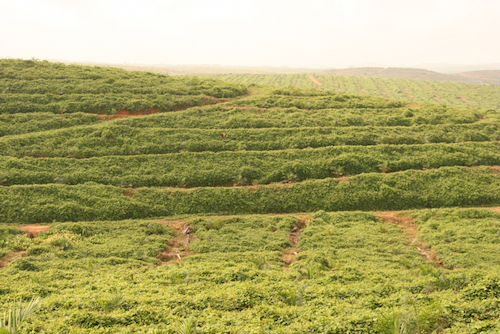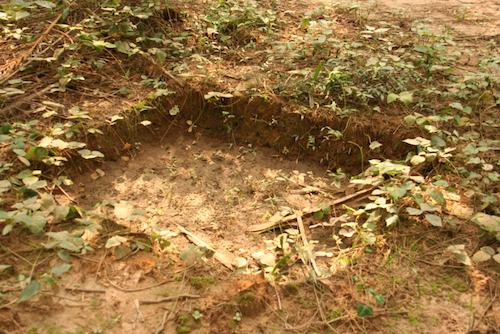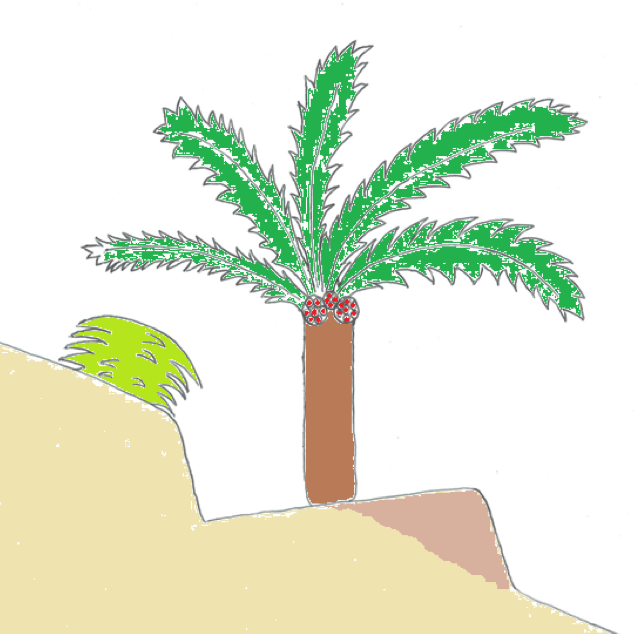Sustainable Oil Palm Farming / Soil conservation
| |
Download: Module 3: Plantation Maintenance
Contents
Background
Soil erosion is the loss of fertile top soil. Soils in the tropics are often very sensitive to erosion, because there is much rainfall which washes the soil away from slopes. Once the soil is lost, it takes a long time to recover, and the fertility of eroded area will be reduced during this period. It is difficult to produce good yields on very eroded soils and soil erosion should therefore be prevented as much as possible. In addition to the loss of fertile top soil, erosion also usually results in the loss of fertilisers and organic material.
Goal
- Maintain good soil fertility
- Prevent erosion of the topsoil
- Limit the loss of fertilisers
- Use water optimally
Standard
- 0—8% slope: No conservation measures needed
- 9—15% slope: Fronds are stacked along the contour line and silt pits are dug next to every other palm
- 16—25% slope: Individual palm platforms are constructed around each palm
- 26—40% slope: Terraces are installed during plantation establishment (see Figure 24)
- 40% slope or more: No oil palm is cultivated
- All soil conservation structures are correctly constructed and in good condition
Timing
- Fronds are stacked immediately after harvesting and after corrective pruning, or just before the rainy season
- Silt pits are constructed during the dry season
- Platforms are constructed during the dry season
Frequency
- Fronds are stacked twice per year and after every harvesting round
- Silt pits are established once, at the start of the rehabilitation process, and maintained yearly
- Platforms are established once, at the start of the rehabilitation process, and maintained yearly
Labour time required
- Frond stacking is undertaken as a part of the pruning and harvesting activities
- Silt pits:
- - One hour for the establishment of each silt pit
- - 2 days per hectare for the maintenance of the silt pits
- Platforms:
- - One to four hours for the establishment of each platform
- - 3 days per hectare for maintenance of the platforms
Equipment and materials
- Frond stacking:
- - Same equipment and materials as for pruning
- Silt pits:
- - Excavator or spade
- Platforms:
- - Excavator or spade
- - Measuring tape (5 m)
Who
Farmers and their families or hired labourers
How
Frond stacking along the contour (9—15% slope)
| Step 1. | Stack some of the pruned fronds between the palm rows, along the contour lines and parallel with the slope. |
| Step 2. | Put some fronds between the palms in a straight angle from the contour stack, in a ‘box shape’ to increase water catchment and decrease runoff (see Figure 23). |
Silt pits (9—15% slope)
Silt pits capture rainwater flowing down the hill. Pits should be 1.5 m long, 0.5 m wide and 0.5 m deep.
| Step 1. | Dig one pit next to every other palm (in the middle between two palms) following the contour line (see Figure 25). |
| Step 2. | Heap soil from the pit on the upslope side, about 0.5 meter above the pit. |
| Step 3. | Stack fronds on the upper side of the soil heap to prevent destruction of the heap or the pit during heavy rain. |
Platform construction (16—25% slope)
Individual platforms should be created around each palm. Platforms should have the following design characteristics:
- Platform diameter should be 4—5 m
- Platform surface should slope 5—10% in the opposite direction to the slope (see Figure 26)
| Step 1. | Dig soil from the upper part of the circle and place it on the lower part. Ensure the bottom (supporting) part of the platform is wider than the top. |
| Step 2. | Compact the soil at the downhill edge of the platform to prevent washing away. |
| Step 3. | Stack fronds just upslope from the platform to reduce water flows 1 |
Data recording
Every soil conservation construction or maintenance activity should be recorded in a logbook as shown in the example below.
| Date | Time | Location | Activity | Input type | Input amount | Input costs | Labour input | Labour costs | |
| People | Hours | ||||||||
| 16/01/13 | Field 3 | Digging silt pits | 4 | 8 | 320000 | ||||
References
- ↑ AA Resources, Soil Management: Soil and Water Conservation Management, Applied Agricultural Resources, Petaling Jaya, http://www.aarsb.com.my/soil-management-soil-and-water-conservation-management, Accessed September 2013.
Acknowledgements
The material from Soil conservation is sourced from Smallholder Oil Palm Handbook and put together by Lotte Suzanne Woittiez (Wageningen Universit) and Haryono Sadikin, Sri Turhina, Hidayat Dani, Tri Purba Dukan, and Hans Smit (SNV) in August 2016. See Module 3: Plantation Maintenance for more information.






